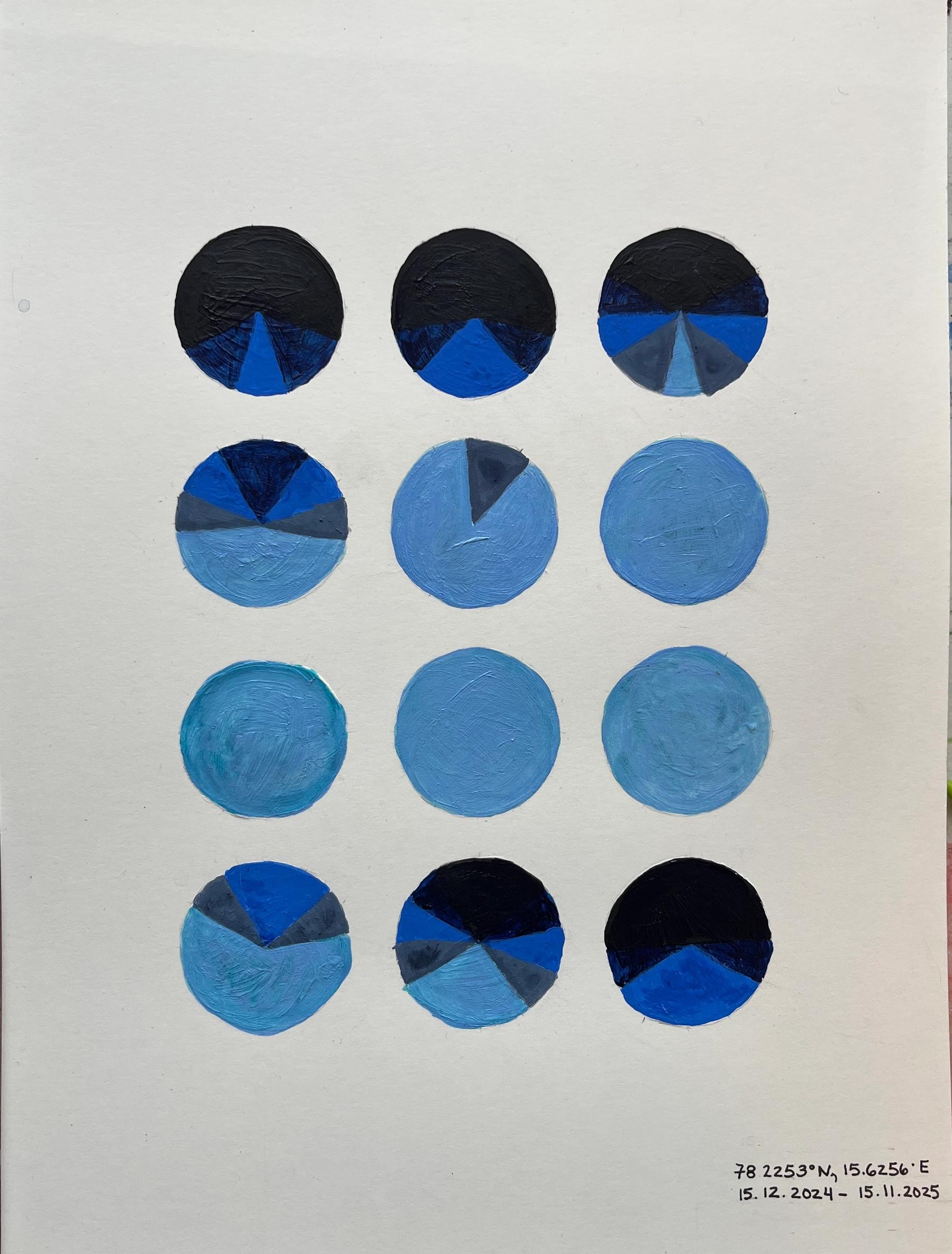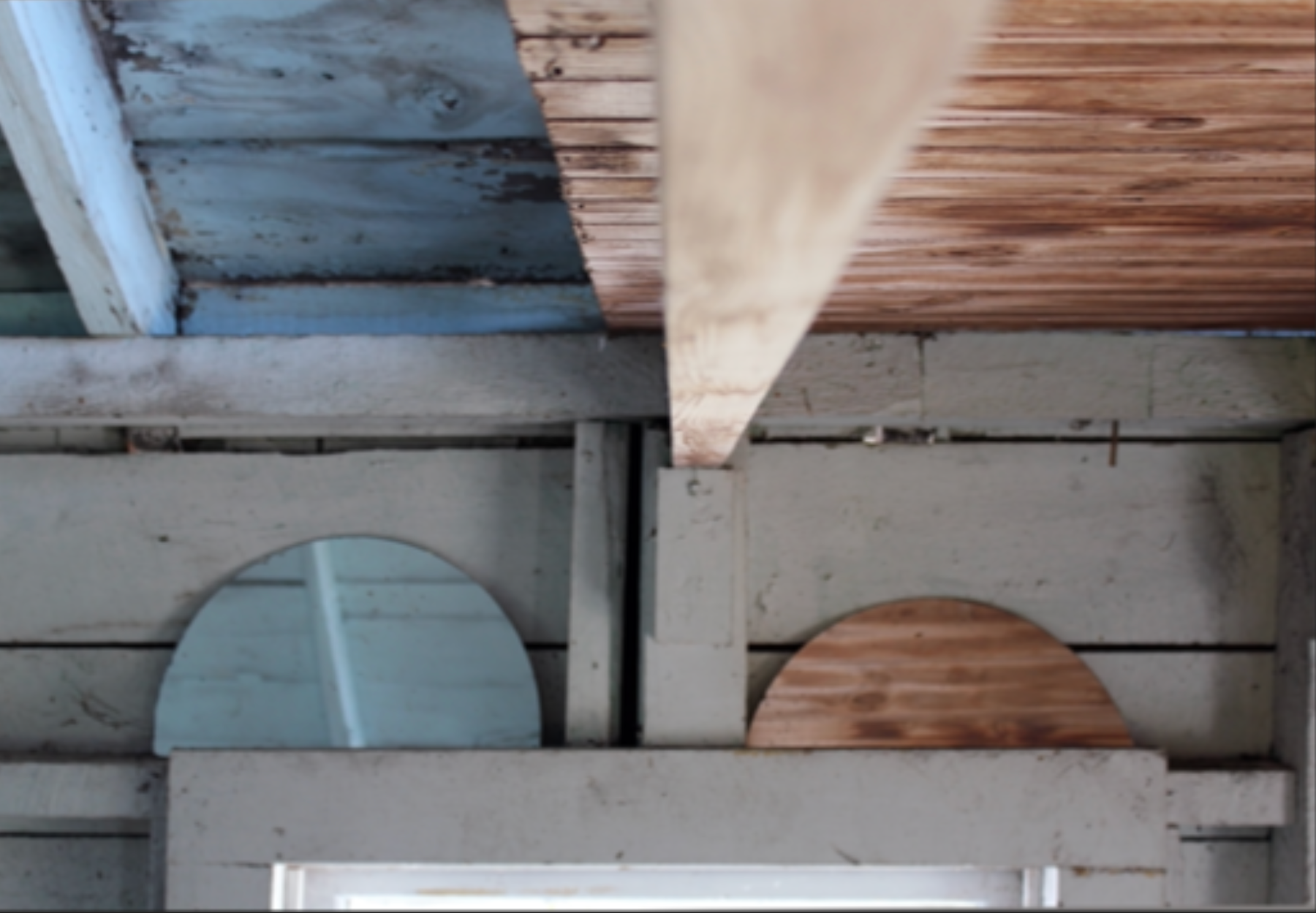
Scanning down the corridor to the windows at the end of the fifth floor of the Porteous building, framed in the farthest window is Patricia Brace ’06 (she/her), determinedly in a backbend, silhouetted by the water in the distance.
Brace is a Visiting Assistant Professor at Maine College of Art & Design (MECA&D), an alum of the BFA painting program, and an interdisciplinary artist with not one but two incredible upcoming artistic opportunities: The 2025 Arctic Circle Residency and The Maine Craft Association Apprentice Program Grant for Blacksmithing. These two seemingly dichotomous endeavors are connected through Brace’s inquiring practice in place and care.
You’ve got two incredible opportunities on the horizon— can you tell me a little bit about The Arctic Circle Residency
The Arctic Circle Residency is this coming May, and I'm going to Svalbard—a Norwegian archipelago. I’ll be on an Arctic sailing schooner vessel traveling around the island for two weeks.
I went to Alaska last summer and had the opportunity to perform on a glacier. It was so inspiring to be on a glacier and think about my body's relationship to this place and what it feels like to perform. The energy of that experience is in reverence to and appreciation of the landscape.
After that experience, I knew I wanted to do that, but through a more research-based trip.
You plan to do 14 improvised performances on the ship for the Arctic Circle Residency, another daily practice. Why do you want to continue that practice, or ritual, in this iteration?
For me, the piece has become about these seemingly distant places like Maine and Svalbard, but how through bodies of water and energy, they're connected.
Because of the nature of the residency, I don't know exactly what I'm going to do. There are going to be nine other people, so my hope is that I end up collaborating with other artists and interdisciplinary people who are interested in researching and being in Svalbard.
The daily improvisational performance is for me, a way to be very present and acknowledge that the glaciers on Svalbard are melting faster than other glaciers, because of its low elevation.

Patricia Brace ’06, Daylight drawings of Waterboro, ME, 2025.

Patricia Brace ’06, Daylight drawings of Svalbard, 2025.
You mentioned how you're going to a far-off place, and how it relates to Maine. Could talk a little bit about your relationship to Maine?
I'm from Cherryfield, Maine, the blueberry capital of the world. As a kid, I raked blueberries, which, growing up in rural Maine, is something that you do for money. So, I have a huge connection to that place and the blueberries themselves. Also, my dad was a mechanic at Wyman's Blueberries for 25 years.
One of the things I'm hoping to do while I'm there is deposit wild Maine blueberry seeds in the seed vault in Svalbard. That's part of that connection of seemingly distant places, making sure that if something happens, those seeds can feed people.
My work now is so much about Maine and place. I live in Waterboro and I'm near Lake Arrowhead which has a lot of invasive aquatic plants. I'm part of a citizen scientist group called Patrollers of Arrowhead's Littoral Zone (PALZ), which goes out weekly in the summer and surveys for plants, in the littoral zone, which is the area near the shore.
Plants that grow where they can still kind of reach the top or get sunlight. I made paper from that work in collaboration with my friend Milcah Bassel. I've also performed in the milfoil (a highly invasive aquatic plant) and that was filmed through a drone. So I've been making a lot of work about the lake and the plants there. Going to Svalbard feels like an extension of that.
Can you tell me about the Maine Craft Association apprenticeship you have with your dad?
We received the craft apprenticeship program through the Maine Craft Association and the Maine Arts Commission. It’s a hundred hours of my dad and I working together. My dad will be the mentor, and I will be the mentee in Ricker Blacksmith Shop, a 200-year-old blacksmith shop in Cherryfield, Maine, that has been run by my dad.
When Cherryfield was a lumbering town, the Ricker Blacksmith Shop built Peaveys, which were used to grab logs from the river. It's a really special place because it's about my relationship with my dad, but the Ricker Blacksmith shop is also about the history of Cherryfield.

Griffin, Arthur. Breaking up log jam - Maine 1939. 1939. Web. 02 Apr 2025. <https://ark.digitalcommonwealth.org/ark:/50959/9z903444k>.
We will work together primarily so that I can learn blacksmithing from my dad and then teach blacksmithing to my students. That's the goal, and then our work will culminate in a collaborative project that will be exhibited during Maine Craft Weekend in October. We'll have another exhibition in November with a collaborative piece that my dad and I make in the blacksmith shop.

Patricia Brace ’06, blacksmithing tests, 2025.

Patricia Brace ’06, Pepper's Ghost Sculpture (Blue), 2024, welded steel, acrylic, 60" x 24" x 36" and George Brace, custom designed table, steel, raw-edge spruce, 2024, 35" x 16" x 35"
I loved seeing your dad’s spiral staircase. The turning of metal is seemingly impossible to a person who doesn't have experience with metal. It creates this thing of wonder.
Absolutely. It's amazing to watch him blacksmith. When I was a kid, he was making those spiral staircases. I grew up with him making hand forged spiral staircases in the shop and then installing them. And so, as a kid, it was miraculous, right? And now, to work together is just as miraculous.
The other day we were forging points, which is a really simple blacksmithing task where you heat up the metal and then forge a square tipped point. He did it in a couple heats, where for me, it’s something that takes all day. It was amazing to watch.
The work is so much about collaboration. This piece for me is more about my relationship with my dad—spending time with him and learning from him. And the blacksmithing aspect of it is almost the byproduct of that, right?

Image copyright George Brace, accessed from www.rickerblacksmithshop.com, custom-designed spiral staircase, private residence.
A phrase that comes up a few times in your writing about your work is “Place and Crisis." Can you expand on what those words mean to you?
I wonder now if it's shifting to Place and Care. That language feels instigatory in a way that felt important to acknowledge the climate crisis, and ways that I can talk about that in my work.
I've been thinking about performance art and the body as a sustainable medium. I can use my body as a medium to activate these places local to me, that I can walk to. So, Place and Crisis, for me, was thinking about ways to encourage care of land.
I think, through this work, I've been shifting that to Place and Care and ways of caring for the collaborations, the people that I'm working with, and the places where we are.
Be that my relationship with my dad, the location of Cherryfield and Ricker Blacksmith shop, my community with PALZ, the lake citizen scientists group, and learning ways that we can work with the plants that are there and still have the lake be a place that people can use.
In Svalbard, I hope it looks like collaboration with the other residents, that we're all learning from the place of Svalbard, and ways that we're learning from each other that's generative. The Arctic Circle Residency is just the beginning of that.

Patricia Brace ’06, Year Long Performance (Day 228), South Rim, Grand Canyon, AZ, 2021.
One of the themes in your work is balance, whether in Dance For Radio where you are balancing public performance of a private experience, or Year Long Performance and Stage where you are literally balancing your body. Can you tell me how you think about balance in your work?
I've been reading Alan Badiou's Dance as a Metaphor for Thought and thinking a lot about balance, but also this weightlessness or this suspension. Through the Year Long Performance, there's a moment that I try to capture that's really fleeting, but often mid jump, or this moment of suspension. And for me, it's a way to be at rest or at peace when I'm dancing. I'm able to be in alignment with my true self.
That's one of the times that I feel the most in tune with why I'm here, and I think that's why I'm a performance artist. That balance is really fleeting, but there are small moments in the performances when it does happen, or it's a moment of suspension, and that's what the work is about.
It also happens through collaboration. The work is so much better when you're working with people and you're able to achieve that kind of balance or suspension, where the work is happening because you've come together to create that relationship. Those are the moments that really fuel the entire body of work. The reason to go to Svalbard.
How does this relate to your conservation work?
Yeah, that's huge. Even going to Svalbard, my climate footprint getting there, right? My climate footprint going to Alaska was huge. That type of travel is contradictory to what the work is about. And then with the blacksmith shop, we’re using coal and steel, and all of these materials that are not good for the environment.
I think for me the work is about acknowledging that. Right now, what I've been doing is tracking and thinking about ways that I can offset that. Is it through planting trees? Is it through education? Is it through conservation and other ways? It's such an important question, that I don't think I've been able to answer yet, but I’m working on trying to do that.
In my class, I always say I'm most excited about the questions that you're asking through the work.

Patricia Brace ’06, photo of half mirror from Patricia’s studio, 2025.
We’re sitting by the sculpture studio windows on the fifth floor. What are some of your favorite places in the Porteous Building?
Here. I really wanted to meet with you here because I think it's so special to be in the woodshop in sculpture and be able to see the ocean. Portland's just such a special place to go to school because of our proximity to these gorgeous natural environments.
Then in the sculpture room, because anything you want to make, you can make within those walls. It's given me a huge amount of creativity and passion in my own studio practice. And the coal forge, but there's a class going on right now.
Do you have a favorite tool in your studio?
I wear this crystal necklace all the time. It's from my stepmom who passed away two years ago—I think it’s one of my favorite objects in my studio. And I have a mirror that was a circle, but it broke, exactly in two. It was something that I took from my grandmother's camp, and it’s one of my favorite objects. It's these objects in my studio that are charged with meaning and support and care for me and my studio practice.
Things that I can go back to and communicate with about the work. Those are placed around my studio as encouragement, support, and this recurring, cyclical source of creativity. That mirror has come back into the work multiple times.
When you leave the house, other than phone, wallet, keys, what do you always bring with you?
Coffee and water.
In 2020 you ran for President. Would you consider running again?
I won't say no.